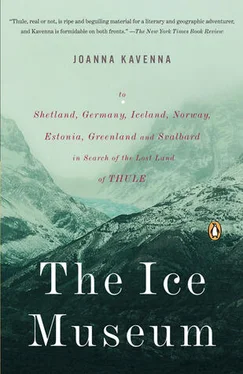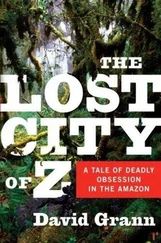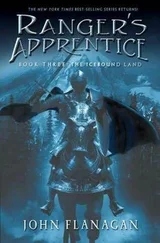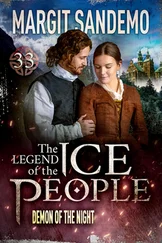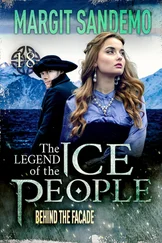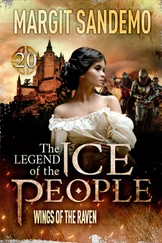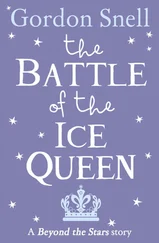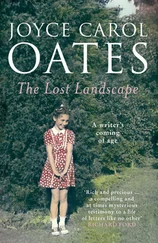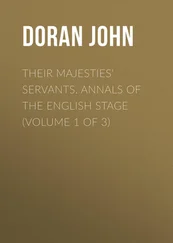Onto the blank resonance of the valley, the cold greyness of the lake, Morris conjured a cast of Saga warriors. Under the shadow of Almannagjá, he imagined immense crowd scenes, with thousands of extras, Viking warriors lurking in every rift. Morris worked himself into a thrilling frenzy, gasping at the cracked earth and the rivers of fire, remembering old stories of Viking warriors. He saw cold blue hills and blackened rocks, and patterned the scenery with imaginary spectres, spilling Vikings, wraiths and eidolons onto the empty mountainsides. He saw a land unlike his own, bringing the consolations of difference—the empty plains, the wide-eyed innocent inhabitants, as Morris found them, living in their simple land. The hills and stark valleys of this Saga-land, scarcely changed since the Saga age.
In 1874, shortly after Burton and Morris had gone home, the new Icelandic Constitution was signed, giving the Icelanders some domestic autonomy, after years as a Danish colony. 1874 marked a thousand years, probably, since the founding of Iceland by the Norse sailors. A host of journalists appeared in Iceland, observing the events, feeding their domestic audience of Saga-fans with news of the liberation of Saga-land. The Icelanders chanted a celebratory verse:
‘Ages thou numberest ten, unconquered and long-biding Thule! Hardy mother of men, Thor grant thee life through the ages, After thy sad, sad past, may Happiness smile on thy future, And Liberty, won so late, crown every blessing with glory.’
We were once Thule, the people chanted, and we will be great again. Just look outside, at our weird country, they might have added; how could we not be great, with this extraordinary auto-mutating landscape, constantly creative, a Protean reverie—stretching and pirouetting into lava statues as far as the eye can see?
The placid waters of the lake stretched beneath, a great sheet of water with an island lying in the middle looking like a broken-down crater, great pointed hills on two sides of it, the heavy grey mountain of Armannsfell behind, and the lava lining the slopes to Skjaldbreiður. The spiky hills stood dark against the sky; the deep water was green like the cold sea. A soft wind blew across the lake, and a long line of mist drifted across the plain. I took a cup of coffee in the Valhalla Hotel. A woman served me, blonde, pale-eyed, setting the coffee down with a watery smile and then disappearing, apparently for ever. I sat in the nearly empty room, with a fire dying in the grate. A German couple sat a few tables away, hidden in the semi-darkness, murmuring a low commentary on the plain. The wind shook the windows. Outside, a van moved slowly across the muddy car park, driving into the misty evening. I watched it cross the valley and the glinting river, until it disappeared into the receding contours of the mountains.
The ring road in Iceland runs north towards the volcanic region of Mývatn, a place of blasted rocks and pastel plains, where the sun lingers through the night in the summer, shining a pale light across the scarred landscape. Through marshlands and craters the road runs, along the base of grey and purple mountains, past blue waterfalls cascading through gullies. Past the petrol stations and snack-bar villages, civilization pared down to essentials. The road turns to rubble at times; it passes through lush green valleys; it rises into grey mountains, past lunar slabs of rock in pastel shades. The mountains become multi-tone—the whiteness of the snow stark against the orange sand-cones and the dark ash slopes. At the coastal towns everything is coated in mist and the dull shapes of farms loom from the whiteness. The road runs past the silver waters of lakes, over the table mountains. When the mist falls away, there are rivers and a few slender firs, clinging to the rocks. There are hotels, surrounded by baroque basalt pillars. The mists swirl across the plains. When the light dwindles, patterns begin to emerge from the lava, the piles of rocks like stacked-up coals, the deep blue river carving a channel through the valley, the conical peaks jutting out of the uneven ground. The lowland plains are coated in grasses, scattered with boulders; the mountain slopes are delicate layers of ash rock, with snow dusting the higher peaks. All these cracked slopes stand with the clouds casting shadows across them, the empty road winding under them.
The landscape is transformed as the road reaches the north. The colours change from gentle greys and browns to the brilliant orange of the sulphur hills, the white of the snow on the peaks gleaming under the silver light. When the road reaches the volcanic centre of Mývatn—a lake blasted by past explosions, surrounded by thick fields of lava—the buses drop off their passengers, leaving them at the hotels and campsites. They are left in a volcanic plain, surrounded by enormous piles of ash and pools of water steaming in the twilight.
I arrive in Mývatn as the landscape fades under a star-swept sky. The bus grinds to a halt in Reykjahlið, the main town at Mývatn, a tiny place of a few houses and hotels and campsites, deluged on all sides by greying lava rocks. Low mountains of sand and ash rise around the town, their colours dull in the twilight. The hotels are all full, so I walk to a campsite on a pile of lava, trying to escape the midges that hang around the edges of the lake. The clouds are thick and black by the time I have put the tent up, and the stars have been obscured. I sit for a while on the lower slopes of one of the hills, looking out at the green islands looming from the rain-spotted waters. There’s a busload of French tourists setting up camp close by, and the smells of their cooking make me ravenously hungry as I sit in the tent, staring at the view. Mývatn is a fire-blasted place of black rocks and steaming sulphur pools, with the volcano of Krafla lurking to the east. At 3 A.M., I am woken by the wind lashing the sides of the tent and the persistent thrum of rain on canvas. I unzip the door of the tent and peer out. The skies are a pale grey; the lake shines under scudding clouds. The islands radiate a cold light. A long lion-shaped mountain sprawls to the west, a table mountain to the south, and another pile of black ash lurks in the distance. The rocks are shaped like creeping shadows. The air smells of rain and moss.
I start awake throughout the night, as if in response to a noise, but whenever I unzip the tent the pale skies swirl silently and the lake gleams under the moon. Nothing moves across the charred rocks, and the irregular mountains cast their baroque shadows on the valley. It’s as if the lake is haunted by the ghosts of explosions, by the shocks and sounds of a rumbling volcano, or as if something in the atmosphere makes me uneasy, causing me to jolt upright at intervals. By morning I am tired and unkempt, mumbling greetings at the French campers, who have already packed up their breakfast things and put on their walking boots by the time I emerge from the tent. The lake is mesmerizing, the wind tousling its surface, the waves sluicing against the spectral moss islands. The whole valley is disorienting; everything is improbably coloured, every rock clashing violently with its neighbour, and the ground I walk upon is pitted and gashed.
Most of the Victorians never reached the north. Many of them turned back at Thingvellir, already satisfied. Slightly exhausted, variously impressed, saddle-sore, Trollope and party trotted back to Reykjavík, as did Mrs. Alec Tweedie, who had much enjoyed her trip in this far-off region of ice and snow, so full of natural curiosities, so abounding in ancient history, so isolated and so quaint. She had not made much use of her fishermen’s boots, but that was for another time, and her serge dress had been most practical. But the stalwarts packed up their horses and travelled north. Muttering about the Sagas, longing to see something still stranger and emptier, something even more like Thule. William Morris trotted north, sounding sporadic eulogies to the simple contemporary Icelanders. Richard Burton galloped north, hardly thinking about the Vikings but fascinated by the exotic, hoping to find more of it. He galloped off, hurling polysyllables into empty space. Erminities of ice and snow, he muttered, twirling his words like batons. Jerking his head backwards, trying to keep a distance between himself and the other packs of tourists.
Читать дальше
